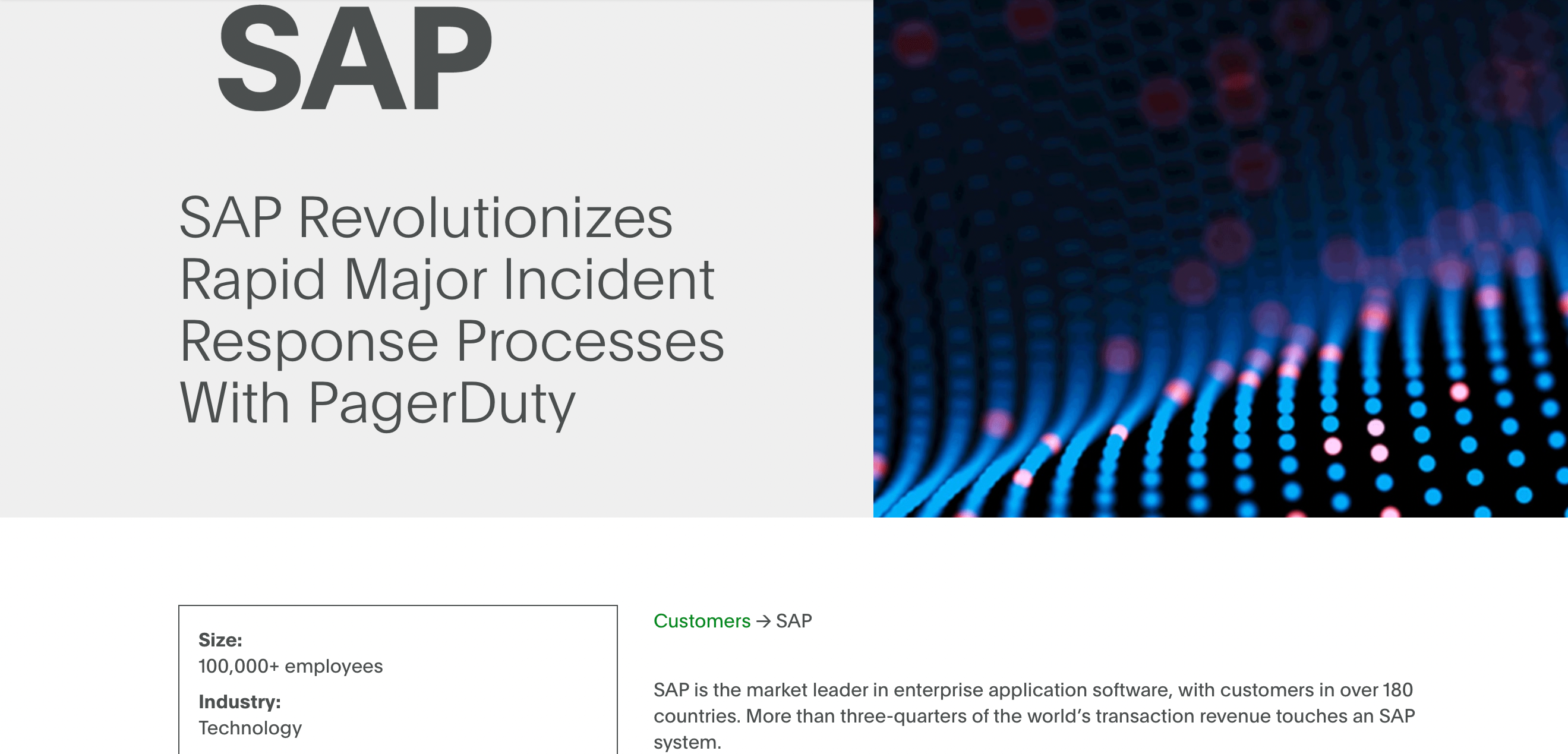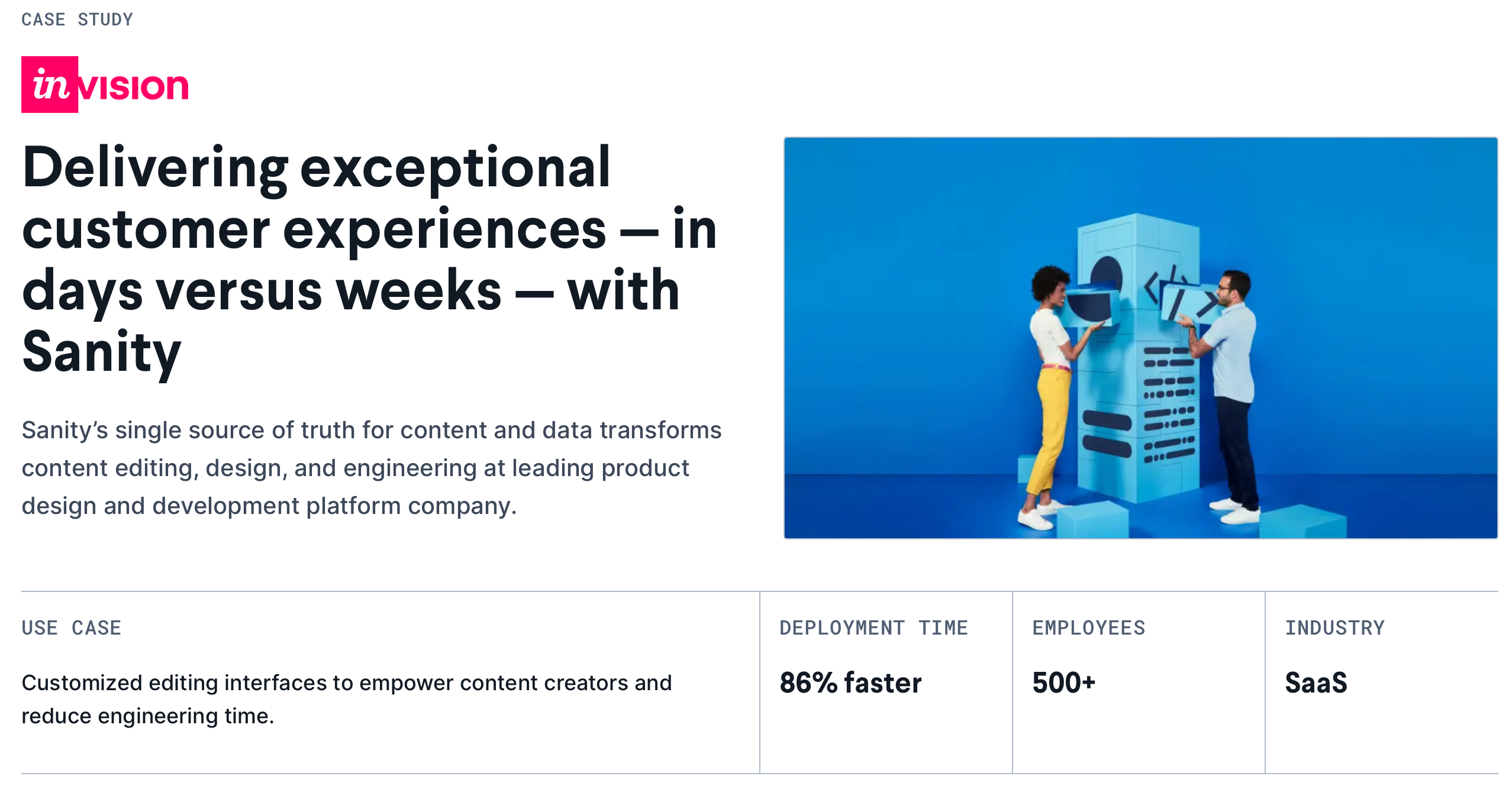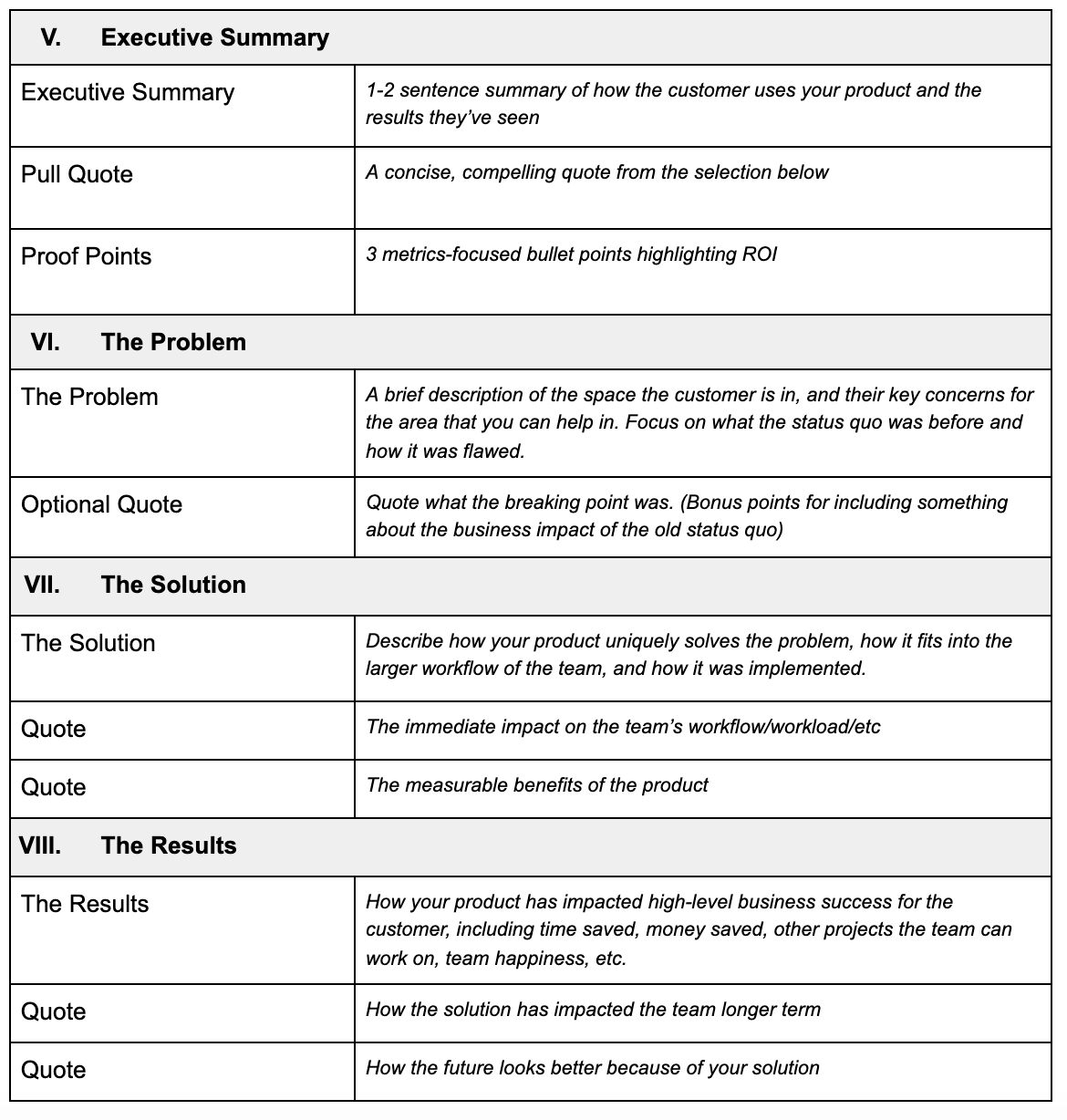How to Craft Your First Customer Case Study
 Ashley Dotterweich
Ashley Dotterweich
So you have an early cohort of happy customers, and you’d like to share their successes with leads and prospects to help attract and close new business.
Now what? We’ve compiled some new and updated tips on B2B business case studies, particularly for developer-led B2B startups, on how to create a case study that accomplishes all your goals.
A well-crafted case study can help show engineering teams why they should use your product, while also showing non-technical stakeholders how their business will benefit.
Distilling a customer’s experience into one brief document can seem challenging, but you can streamline the process with a simple framework. Let’s discuss how to write a great case study that clearly communicates the value your company provides.

Smartsheet covers real-world value to its customers in its case studies.
The Value of Case Studies for Early-Stage Companies
In B2B marketing, case studies are essential to provide social proof. You’re getting a customer (ideally a high-profile one) to say publicly, “Yes, your product solved a problem for us!” For startups, demonstrating that successful organizations are willing to invest in your product is key.
But what makes case studies doubly useful for early-stage companies is that they offer a roadmap for your prospects.
If you’re building a solution with a novel approach or in a completely new space, it can be hard to communicate exactly how your solution is valuable. Case studies provide context and details about how other teams are using your product. The context helps prospects understand specifically how your solution will impact their team.
For startups, while you may start from a humble case study brief, the goal is to create a case study that shows both the business value and the technical context of your product.
Planning Your Case Study
For additional insights into the case study process, we got some additional insights from Joel Klettke of CaseStuddyBuddy, which we’ve added to this section. Before you get customers involved, you need to be clear on your goals for the piece(s) you’re planning to create, and (ideally) how you plan to leverage the story you capture.
You want the stories you tell to be intentional, relatable, and persuasive, which means going in with a clear picture of what details will hit hardest for your leads and prospects. Here are some important case study questions to consider before even talking to your customers:
For example:
- What markets or areas are you trying to target?
Maybe you can feature stories from a specific vertical (such as fintech or e-commerce) or functional group (such as DevOps or product management) to which your company wants to sell. - What personas or roles are you trying to reach?
Your target personas should inform the level of detail and what you emphasize in the stories. Who are the decision-makers you need to persuade? Are you targeting executives at earlier-stage companies who have purchasing power, or mid-senior engineers at more-mature firms who might have to create a business case for your product? You’ll likely want to consider your ideal persona when choosing people to interview so that leads can see themselves in your story. - What objections would your sales team most love to be able to counter with a story?
You may be able to make those objections—and how the customer overcame them—obvious in the story in such a way that it inspires others to act. - What questions or hesitations are you bumping into that a story could help illustrate?
Similar to the above, you can have your interview subject list the hesitations they had, verbatim, and how they no longer have any such concerns as a happy customer. - What outcomes are your leads seeking?
Focusing on valuable, desired outcomes that appeal to your target audience will appeal to them and may influence a buying decision. - What aspects of your offering could you clarify through a story?
It’s important to remember that you don’t always get to choose your first touchpoint with your prospects. Understanding that your next case study could be the first contact a prospect has with you will help you decide where to spend your bandwidth on details and explanations within the piece. Of course, when you use them properly, case studies can be much more than purely marketing content.

PagerDuty offers case studies in a variety of formats, including written, video, and blog.
Choosing Your Formats
In terms of the format(s), you might think you can only use a B2B case study one way: As a write-up on your website or a PDF you send to potential customers as part of your standard content marketing work. Not the case.
You can use case studies in ads, nurture sequences, RFPs, landing pages, cold outreach, live sales presentations, and more—but not if you only tell the story one way, in one place. Instead, consider the needs of the different channels and audiences.
It’s important to think through every way you can use a case study as part of your larger marketing strategy, to drive lead generation at the top of your funnel and win more deals at the bottom.
For example, could you produce:
- One-sheets: A brief version for cold outreach or post-call follow-up?
- Audiograms: For use on social media (particularly on LinkedIn or Twitter, as applicable) or in ads to let prospects hear those glowing words from your customers themselves?
- Slides: A persuasive slide in your next sales deck that reinforces your product’s value?
- Blog: A Q&A-style blog post that reads like an interview with a prominent person in your space?
- Quotes: An eye-catching pull quote for your company’s homepage from a high-profile customer?
- Talking points: A relevant anecdote to mention on podcasts you may be recording or appearing on?
- PR pitches: And potentially as your company matures, a PR pitch to trade outlets that cover topics relevant to your customers?
Consider the different formats you plan to use for your next customer story and make sure you get everything you need from your initial conversations with your busy customers: The long-form case study story to feature on your website, the quick-hit sound byte for your social media channels, the executive summary containing all the success metrics and value you delivered for your sales team’s next deck, and all the rest.
Getting Customer Buy-In
It’d be nice if every customer spontaneously put up their hand and volunteered to take part in a case study, but in reality, you’re going to have to ask them to take part.
Don’t panic. The key is to set expectations and give them a sense of control.
Clearly Set Expectations for Customers
When you make the ask, be clear about why you’re asking them (specifically) and what parts of the relationship you’re hoping they will speak to. A clear ask helps them feel comfortable and prepared in terms of what they’ll be asked to discuss.
Then, lay out what’s involved from a high level, for example: “The entire process involves a short interview on Zoom, with a chance for you to review the draft before it goes live. It should take no more than 45 – 60 minutes of your time.”
If you can, send an example of what the final product will look like—even if it isn’t your own. Examples help customers visualize a nice, polished asset and take the mystery out of the end product.
Clearly Set Expectations for Your Own Team
It’s probably a good idea to calibrate your team’s expectations as well. Unless you specifically added a clause in the sales contract that requires this particular customer to provide testimonials (which some companies put on the table as a bargaining chip during the sales process), case study participation is optional.
Customers not bound by contractual obligations may decline to participate, potentially because they’re too busy, or because they may be having issues they’d prefer to resolve first. Put yourself in the best possible position to secure case studies. Work with your customer success team to find customers who are happy, successful, and not under time pressure to deliver other projects of their own.
It’s also a good idea to keep in mind that customers at larger companies may need approval from their PR experts, marketing team, or legal department before finalizing case studies. In such cases, you may be in for a considerable wait. One that is, sadly, out of your control.
Give Customers a Sense of Control
Always let your clients know that they’ll have a chance to review a draft and request changes. You can let them know you’ll be happy to make any changes or revisions they request to make the process fast and simple.
Essentially, the better you communicate your process, the ‘why,’ and the final deliverable, the more likely you are to get a “yes!” Here’s a full blog from CaseStudyBuddy that focuses on how to get your customers to agree to case studies.

Sanity ensures that success metrics are front-and-center in its case studies.
B2B Case Study Interview Questions
Who Is My Ideal Interview Target?
Your case study should reflect the perspective of your buyer — if you’re selling to VPEs, aim to interview the VPE. Depending on the size of the team and who is using your product, you might need to find a balance between someone who is high-level enough to understand the business value that your product brings, but technical and in-the-weeds enough to know how the product is being used day to day.
It’s OK to interview more than one person, but more viewpoints can be hard to wrangle, and for right now we’re aiming for simple and effective, so stick to no more than two to three interviewees.
10 Critical Case Study Interview Questions (and One Helpful Bonus Question)
Your case study interview should be a conversation, not an interrogation. Prepared questions help you hit all the important points, but before every case study interview, review these template questions and customize them for the particular use case.
Here are the most important case study interview questions to use when interviewing customers for case studies. (Obviously, you should adapt the questions to be most relevant to your company and its audience, and over time, you may want to incorporate them into a case study questionnaire template for repeat use.)
- What is your role/what does your company do?
- What did [process] look like at your company before? What were the biggest pain points you experienced?
- What was the breaking point where you decided to look for a solution?
- How did you find out about [our product]?
- What was the first moment where you realized that [our product] was a unique solution to your problem?
- What does [process] look like at your company now?
- What other software/apps/tools do you use as part of your [process] workflow?
- Are there any quantifiable metrics that you use to measure the impact of [our product]? Can you share any of those numbers?
- What has your team been doing with the time/budget/etc they save?
- What’s one thing you’d want someone who is considering using [our product] to know?
One question that isn’t on the list that you should always ask at least once: “Can you tell me more about that?” An interviewee might gloss over a detail that they find mundane, but which will be critically interesting to your prospects. For technical products, such details often end up being related to their tech stack and the other tools they’re using, and can often help you tell a stronger story about how your product delivers value. Always dig deeper.
As a logistical note, consider recording your case study interviews. Frantic note-taking to capture every word distracts you from staying in the moment and being able to ask meaningful follow-up questions. Just remember to get their approval to record the call before you start the conversation since there are laws in place, such as California’s “eavesdropping” statute, that require all parties to consent to recording in advance.
An Effective B2B Case Study Template
Once you have your customer’s story, you’ll need to transform it into a format that has a strong narrative and is easy to skim. This is the case study framework template that I’ve found most effective for creating concise, impactful case studies quickly. Grab a copy of the template here.

Now you’ve identified and organized your key points and quotes, it’s time to write! Your goal is to craft a cohesive story around the customer’s buying journey and product use. Writing case studies doesn’t need to be an overly long project. Keep it as short as you can without losing the overall context of the use case.
A Note on Success Metrics
As we mentioned earlier, one of the key questions to ask customers is about quantifiable improvements they’ve seen as a result of using your company’s products. While not every customer may have hard numbers on hand to share in the moment as you’re interviewing them, metrics are a key part of making your success stories impactful.
Be prepared for the possibility that your interview subjects might not have the success metrics you’re looking for during your conversation. Keep a few possible alternative metrics in mind you might ask them about that pertain to your product’s value proposition (such as revenue generated, hours saved, number of incidents reduced, improved SLA performance, or whichever metrics are relevant to you). If your subjects are open to double-checking on certain metrics to provide later, it’s a good idea to include placeholder success metrics in your case study draft for customers to fill in or update later.
A Note on Formatting
In terms of formatting, it’s also a good idea to break up your case study into subsections with clearly-marked headers. Subsections and subheaders make your case studies easier to read, easier to skim, and easier to index on search engines for SEO purposes. You can also visually break up all your text with customer quotes, product images, and if you have the resources, an infographic or two that depicts the value your product provides.
It’s also a good idea to consider adding a clear CTA (call to action) within your case studies, such as to read other, similar content you’ve created for similar use cases or similar verticals. Adding a CTA with links to additional, relevant content can encourage your prospects to “binge” on your content and learn more about your product while you have their attention.
A Note on Quotes
Customer quotes are at the heart of a good case study. But people don’t always speak in crisp, clean sentences that lend themselves to sound-bytes. Lightly editing quotes to be clear and usable out of the context of the conversation is an important step.
However, when cleaning up your quotes, be careful not to sanitize them too much. You’ll quickly find that they all start sounding robotic and fabricated. If your final quotes read like carbon copies of your messaging framework, you’ve gone too far.
Ship It and Celebrate!
Get the Thumbs-Up
Unless you particularly enjoy speaking with angry communications managers and lawyers, always give your case study subject the chance to review the final version before it goes live.
Two things to do to keep the review process quick and easy:
- Minimize editing rounds:
Review limbo is usually where case studies get stuck, so minimize the back-and-forth as much as possible. It’s a good idea to send a PDF of the final mockup along with a Google Doc for editing, as having the “final” visual helps push stakeholders to give feedback. - Set a hard publish deadline:
Saying, “We’re planning to publish on MM/DD, please let me know if you have any edits by MM/DD” can drive a quicker turnaround in a way that open-ended requests can’t.
Distribute Your Case Study
Completing your first case study is something worth celebrating, but your work isn’t done. Publish it to your website, share it with your team and other customers, and promote your new case study to your target audience based on the formats you evaluated previously.
We dive deeper into how to leverage user stories effectively in another article, which you can read here!
Case Study Examples
So now you know some important tips on how to write a B2B case study. To help you get a better sense of what the final product should look like, we asked Joel to share some of his favorite examples of customer stories for SaaS companies and developer tools. Here are some examples of great case studies to consider:
For examples of some real-world B2B, developer-focused case studies, check out these:
- LaunchDarkly follows our case study framework for clear, easy-to-parse user stories
- SmartSheet also uses customer quotes to frame user stories and highlights specific use cases.
- PagerDuty offers a variety of formats for customer case study content, including full written articles, blogs, and video
- Snyk offers compact case studies packed with customer quotes and visuals to be easily skimmable
- Sanity.io offers beautiful case studies broken up into easily consumable subheadings with plenty of embedded visuals
- Radar uses a somewhat minimalist customer case study template that leads with success metrics and tells a before-and-after story by highlighting “the problem” and “the solution”
- Tailscale weaves in-depth stories that cover each customer’s vertical and unique business challenges to properly frame the problem, and how it provided a valuable solution
- Mux, being a video platform, adds both a video and a written component to each of its in-depth case studies
Here are some additional videos walking through best practices for case studies provided by Joel:
- Integrate.io - A walk-through of a case study for this SaaS company covering content layout and how easy your case study is to skim
- Rainforest QA - An additional walk-through of a case study covering the importance of customer quotes and success metrics
Subscribe to Heavybit Updates
You don’t have to build on your own. We help you stay ahead with the hottest resources, latest product updates, and top job opportunities from the community. Don’t miss out—subscribe now.
Content from the Library
How to Create Buyer Personas Your Team Will Actually Use
Buyer personas are an essential building block for any marketing strategy. Coupled with strong messaging, they help the team...
How to Think About Positioning for Open Source
Positioning Open Source for Your Community (and Yourself) Why is Heavybit posting this extensive interview on thinking through...